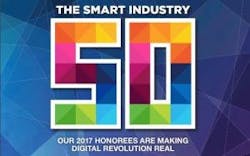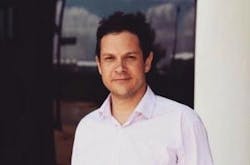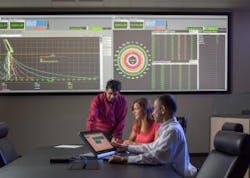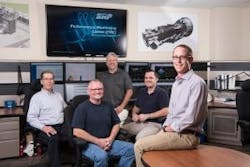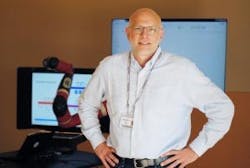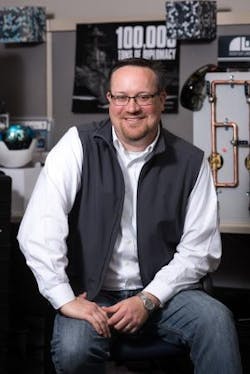By Keith Larson, Editor in Chief
Even revolutions are hard to see when you’re in the midst of them. Certainly, there’s a generous dose of marketing hype around the potential of the Industrial Internet of Things, cloud computing and big data analytics to advance industrial performance and remake business models. But speak to those on the front lines of digital innovation and their stories make clear that industry is indeed in the midst of an accelerating transformation made possible by increasingly powerful and accessible digital technology. “Some say we’re in the midst of a fourth industrial revolution,” says Steve Jones of Steelcase, one of the class of 2017 Smart Industry 50 honorees. “That’s a bold statement, but I think it just might make forAutomotive disruptor
Justin Fishkin says he’s not a car guy. And to spend any time with him, he seems unlikely to have been an investment banker either. Nevertheless, a passion for energy sustainability led him from Goldman Sachs to Richard Branson’s Carbon War Room to his current position as chief strategy officer for Local Motors. There, the economics major stands at the leading edge of automotive industry innovation, building the first flexible digital production network and reinventing how vehicles (and other large products) are designed, built and commercialized.
Local Motors’ list of vehicle innovations includes the first crowd-sourced car design, for the Rally Fighter in 2009, as well as the Strati, which in 2014 featured the industry’s first 3D-
"Rather than having a million copies of one car made in one place and shipped around the world, why not enable communities to define their own mobility futures?" Local Motors' Justin Fishkin
printed car body. But additive manufacturing on a physically large scale is an almost coincidental aspect of the Local Motors philosophy. Indeed, the company’s transformative approach to manufacturing is far broader, building on collaborative design principles (an open community of 70,000+ contributors earn royalties for ideas that are used) as well as distributed micro-production facilities that rely on the extensive digitalization of supply chains—from CAD through final production.
“Rather than having a million copies of one car made in one place and shipped around world, why not allow regional actors to design, produce and upgrade application-specific vehicles compatible with local technologies, infrastructure and energy ecosystems?” Fishkin asks. “It’s economy of scope vs. economy of scale. We can make smaller lots of more differentiated products at higher margins. By connecting a digital thread between design and flexible production we’ve reduce the minimum efficient scale for producing new vehicles and deploying new technologies. This is enabling communities to define their own mobility futures.”
Fishkin first realized the shortcomings of the auto industry’s status quo when as senior portfolio manager at the Carbon War Room he was working to help island economies reduce their dependence on imported diesel, which means that islanders can pay as much as a 40% premium for imported energy. He approached several carmakers with a proposal to build 50,000 cars over 5 years with a particular drivetrain optimized for the island of Samoa. “They laughed at me,” Fishkin said. But when he met Local Motors co-founder and CEO John B. Rogers, “a light bulb went on,” and a job change soon followed. “I’m not a car guy, but if you can materially impact 70-80% of the energy used in a community and bring advanced manufacturing jobs and a flexible production capability in the process, it will have a knock-on effect,” Fishkin says.
Last year, Local Motors unveiled Olli, an autonomous, electric and user-friendly transport designed for relatively low speed, first- and last-mile applications (see photo). “We went from design to driving around in less than three months,” Fishkin says. Now, orders are rolling in from around the world and Local Motors has the opportunity to “walk the walk,” he adds. “We continue to push forward, to prove the Local Motors platform can deliver a product with global demand while simultaneously scaling our capacity to commercialize concentrated pockets of new technologies three to five years before mass-market adoption.”
Local Motors has also introduced Forth, a white label, software-as-a-service version of its platform that is enabling companies like GE and Airbus to radically accelerate their own product development processes using co-creation and micro-manufacturing.
Fishkin envisions a not-too-distant future in which locally manufactured vehicles and other products will be hardware upgradable (much like software is today), as well as fully recyclable to provide local, cradle-to-cradle sustainability. “In 10 years, what Local Motors is doing today will be ubiquitous across many industries,” Fishkin believes. “Innovation will be open and participatory, local and distributed.”
Pattern recognition
While Beatriz Blanco holds degrees in mechanical engineering and business administration, she professes a true first love for mathematics and analytics. And as engineering manager for Mitsubishi Hitachi Power Systems' (MHPS) Remote Monitoring Center (RMC),
“I’m looking to identify the root causes of problems and potential problems based on patterns in data.” Beatriz Blanco manages the Remote Monitoring Center of Mitsubishi Hitachi Power Systems, helping to monitor and diagnose potential problems with the company’s fleet of gas turbines.
she may have found the perfect place to apply her combination of skills and interests.
“I’m not looking at actual parts, touching and feeling physical things,” Blanco says. “Instead, I’m looking to identify the root causes of problems and potential problems based on patterns in data.” In the case of the gas power generation turbines Blanco is responsible for monitoring, a catastrophic failure could mean 45 days of downtime and millions of dollars in repairs and lost revenue, Blanco explains. “When we can prevent those sorts of losses on behalf of our customers, that’s really exciting.”
An integral component of the long-term maintenance and service agreements that MHPS holds on behalf of its power generation clients, the RMC was established to provide real-time monitoring and analysis of data from gas power generation turbines across its clients’ operating fleets. Approximately 6,000 to 12,000 data points are monitored for each gas turbine configuration, allowing MHPS engineers to compare plant performance to trends as well as collaborate in real-time with plant operators.
The team uses the data as fodder for predictive models and diagnostics, and Blanco is working to make these models increasingly intelligent. “My focus is to provide 24/7 service for our customers, and to improve the processes and tools being used internally,” she says. One example of the latter is streamlining—and automating where possible—the hundreds of performance reports produced by her team each quarter, Blanco says.
This frees the center’s engineers to do more important work, such as creating diagnostic tools that apply fleet-wide knowledge of failure modes to incoming turbine data. “We’re using Bayesian analytics to attach probabilities to a range of possible causes [of anomalies in the data],” Blanco explains. More efficient use of the engineers’ time will be particularly important as the center prepares to move to Total Plant Monitoring by 2018, extending the center’s scope of responsibilities from the rotating equipment to steam generation and balance-of-plant functions.
Blanco and her team also are working to create automated tools for startup and shutdown analysis. “Can we use data to predict if a startup will go smoothly? And if it fails, why did it fail? What was different and what was the most likely cause?” she asks. Instead of visually inspecting and comparing trends, “we want to automate that process,” Blanco says. “We’re not aiming to replace the engineers, but to enhance their ability to come to conclusions more quickly.”
Peering into the future, Blanco believes that the power generation industry will feature increasingly autonomous plants, and that maintenance will be entirely condition-based. Wind power will be the first to go fully autonomous, she predicts, as wind turbines consist of fewer components. And however fast technologies such as machine learning and artificial intelligence transform performance of the power industry’s generating assets, she expects to be in the thick of it—applying the power of data analytics to industry’s latest challenges.
Trading places
Ashe Menon has long understood the potential of digital technology to transform the performance of industrial assets. In 2002, Fitiri, a startup launched by Menon and his friends developed RigMS and PlantMS, asset management systems for the upstream and
“We want to come out of this downturn leaner, meaner and smarter.” As vice president of global manufacturing for National Oilwell Varco, Ashe Menon has turned his expertise in remote asset monitoring and condition-based maintenance to improving the company’s internal operations.
downstream oil and gas industries. The systems leveraged RFID technology, mobile devices and reliability-centered maintenance strategies to optimize operations and minimize downtime. The RigMS Division was acquired in 2006 by National Oilwell Varco (NOV), a worldwide leader in the design, manufacture and sale of equipment and components used in oil and gas drilling and production operations.
Menon came along with the acquisition, and worked to increase adoption of the NOV asset management solution among the company’s energy industry customers. As the director of equipment optimization he was then involved with applying condition monitoring, condition-based and predictive maintenance strategies to NOV capital assets to reduce unplanned downtime. This also involved deploying machine-learning technologies on rigs to understand why they fail and how to prevent these failures from happening. His next move was a corporate role as the director of asset management, which was more internally focused on leveraging those same technologies to reduce the total cost of manufacturing across all of NOV. Both roles were focused on increasing the uptime of high-criticality assets.
Then came the downturn of 2014, and with crude prices now half what they had been only months before, Menon had a new job. As vice president of global manufacturing, he was tasked with turning his attention further inward on a specific division to help the company leverage technology to transform the company’s manufacturing operations. This would allow NOV to maintain a competitive advantage in what had overnight become an increasingly cutthroat market.
The company focused first on the basics, making sure that efficiency, quality and on-time delivery hadn’t slipped during the boom years. “Then we spent a year and a half studying our critical equipment, doing FMECA (failure mode, effects and criticality assessment) on all our critical equipment so that we understood what failed and why,” Menon says. “That allowed us to determine what we should instrument first. Only then could we turn to the Industrial IoT.”
Menon has cultivated an understanding of what’s possible with digital technologies. He pushes stakeholders to justify investments based on clear returns and to finance those internal investments out of operational savings, not capital budgets. “Decision-makers across the company have the same responsibility to protect profitability as the CEO,” Menon explains. “The focus is always on total cost of ownership: do those things that will maximize output and provide the biggest bang for the buck.”
Menon is proud to have had a role in keeping NOV profitable through this difficult time of adjustment, and believes “we as an industry have the technologies to come out of this smarter.” In particular, he sees digital technology as having the potential to dampen the feast-and-famine cycle of the oil industry that in turn results in the cyclical hiring and firing of workers. “My biggest emphasis is to hire well and keep competent workers on board, and keep making them smarter by maintaining the culture of a learning organization. Most will come out of this downturn leaner, some will come out leaner and meaner. We want to come out of this downturn leaner, meaner and smarter, too.”
“Some have asked me if I’m bored in this new position, since ‘You’re just doing manufacturing and not innovation,’” Menon adds. “I say, ‘Are you kidding? We are innovating in ways that truly matter to our customers.’”
Digging in the dirt
Like many budding engineers his age, a young Atif Khan had a fascination with Legos and then with computers during his formative years. At university he focused on the programming, later rediscovering his passion for the interface between cyber and physical systems when assigned a board-level industrial design job to create a foot-operated
“From machine automation, my interest moved to data and what could be done with it.” The Climate Corporation’s Atif Khan is helping to digitalize precision agriculture on behalf of food producers worldwide.
computer mouse for medical applications.
That experience led him to the world of embedded computing—“It was awesome to work on a board!”—and from there into the deep end of industrial automation at Sandvik, where he had the opportunity to create an automation department within the company’s mining and rock excavation machinery division.
“In 2009, it was still the dark ages in terms of automation in that part of the company,” Khan says of the 250-ton, largely manually operated drilling machines that he and his colleagues set about automating. “We were the first controls engineers there,” he says.
Automation proceeded in a stepwise fashion, enabling the machines’ human operators to perform their duties more efficiently and productively. For example, each time a drilling machine was moved, it had to first be levelled and stabilized using four hydraulic jacks, one at each corner. “The levelling task took a human operator 20 minutes before being able to be productive,” Khan explains. “In three months we demoed an automated system that levelled the rig in 30 seconds. It went to market as a retrofit for our existing machines.”
The team tackled other routine operator tasks such as for auto-drilling (controlling the rate at which the drill bit descends and ascends), and over the course of seven years produced a fully autonomous, remotely supervised machine that did pretty much everything except move itself—which was not pursued for reasons of safety.
And if mining’s digital transformation is advancing at a rapid pace, agriculture may be poised to move even more quickly, Khan says of his new home at The Climate Corporation, Monsanto’s Digital Agriculture arm, where he is now senior manager for connected systems and equipment automation. “From machine automation my interest moved to data and what could be done with it,” he says.
Responsible for connecting sensors to cloud networks and advancing soil sampling automation, Khan is helping to digitalize precision agriculture on behalf of food producers worldwide. A more timely, more granular view than what is available from satellites—even down to the plant level—is needed to fully optimize crop production from planning through planting, treating and harvesting, Khan says. “We’re looking to leverage integrated data flows all the way to the harvester.”
Data-driven decision-maker
As production systems senior advisor in BP America’s upstream organization, Dave Feineman has had his hand in a broad range of the supermajor energy company’s technology initiatives over the past several decades. In the early 2000s, for example, he worked on a virtual project management hub designed to facilitate collaboration and improve work-process efficiency among the company’s far-flung global project teams. Then it was on to the BP’s Field of the Future technology program, an ambitious, decade-long effort that saw real-time operational data liberated from local control rooms, up and out into the broader organization for improved decision-making.
And for the past two years, it’s been the Plant Operations Advisor (POA), a pioneering digital solution developed with GE that aims to increase facility reliability through new process surveillance and predictive analytic tools. After a successful pilot in the Gulf of Mexico, POA is planned to be rolled out to some 30 large production assets around the world by the end of 2018. This unprecedented speed of implementation is possible only because standing up each asset is primarily a matter of configuration, not hardware-based, boots-on-the-ground commissioning, Feineman says.
But as immersed in technology as Feineman has been, he remains most interested in transforming the business. “I’m a business guy, not an IT guy,” he says. “I’m more interested in workflow design and managing change in order to realize value—rethinking how work gets done. I look for business problems, then for ways to link up people with processes in order to deliver value faster. Right now we have many things connected and spouting data – we’re pumping a billion records into a data lake every day. We have digital twins,” he says. “Next, the question is how do we move into data-driven operational decision-making? It’s not just a matter of technology.”
Indeed, Feineman sees the ongoing transformation of industry across three time horizons. Organizational efficiency is up first. “We need to understand how our decision-making processes evolve when they are driven by data.” Next up will be to drive proactive interventions such as predictive analytics throughout the organization. “We need scalable methodologies that work in the real world—tools that are usable by all, not just data scientists.” Further out, he envisions the predictive, virtual enterprise. “With proactive interventions, problems won’t become so severe. We’ll also be more agile – we’ll see further down the road and be able to move more quickly.” These developments point to the real possibility of large-scale, unmanned operations, Feineman predicts. “We’ll be rethinking the way facilities exist and how they are controlled. As with cars, we’ll embrace increasingly autonomous operations.”
With oil prices likely to stay low for a long time, energy companies like BP will do all they can to increase efficiency and reduce capital costs—and that means implementing digital technologies. “Is it possible to transform a conservative industry into something that’s far more digital and agile?” Feineman asks. “That’s the exciting part.”
Power player
It’s said to be human nature to resist change, to gravitate to the familiar. Apparently, someone forgot to tell Andy Johnson. He’s been with Salt River Project (SRP), a metro-Phoenix electric and water utility, for 15 years, having started in the company’s Rotational Engineering program. Since then, the civil/environmental engineer by training has served
Andy Johnson (foreground) and other members of Salt River Project’s Performance Monitoring Center team are helping the company to supply electrical power more reliably, cleanly and cost-effectively.
four tours of duty in various areas of the company, each time with increasing levels of responsibility. “It seems like every four or five years I move into a position which is completely outside of my comfort zone,” Johnson says. “I’m always looking to expand my career experiences and to take on new challenges.”
Today, he heads the company’s Performance Monitoring Center, leading a team of highly skilled analysts and mechanical engineers responsible for tracking and analyzing the performance of critical equipment across SRP's power generation fleet. “We’re looking to save the company money and improve customer service through the early identification of equipment issues and process changes. This monitoring extends the life of equipment and improves equipment efficiency while also providing our customers early warnings of issues and the lead time necessary to address issues during planned outages and maintenance activities.”
The group quantifies its effect on the SRP’s operations by measuring “saves,” that is, the independent, actionable identification of an issue of which there was no prior knowledge. Over the past several years, the team’s ability to deliver useful information to operations—as measured by the ratio of saves to issues identified—has increased from 38% in 2014 to 72% today. And while it’s always difficult to measure the value of preventing something that didn’t happen, they’ve created an “estimated monitoring value” (EMV) metric that reflects the value of a save with respect to its possible implications if unaddressed. Results have run into the millions of dollars, including a recent quarter when EMV topped a conservative value of $700,000.
Originally focused on rotating equipment reliability and attendant predictive analytics, the scope of SRP’s Performance Monitoring Center has expanded to include thermal performance of the generating units. “Our fleet is becoming more reliant on natural gas and ensuring that these units are performing from not only a reliability perspective, but from a thermal performance perspective, is all the more important,” Johnson says. “This plays directly into our corporate goals of being a leaner, greener and even more customer-centric company. Leaner, in that if we can identify performance issues, we can generate more megawatts with less fuel. Greener, in that by using less fuel, we are reducing emissions. More customer-centric, in the sense that our plants operate more efficiently and ideally, more reliably.”
Johnson is particularly proud of the team he’s been empowered to build. “Without this group of highly motivated and educated individuals, we would not have been successful in building out a world class monitoring and diagnostics center,” Johnsons says. Indeed, the multidisciplinary team of five includes former plant staff with varied talents and decades of experience. It was awarded the company’s prestigious “Operational Excellence” award in 2016 from among 24 other submissions. “By leading through continuous improvement, we were able to provide the justification that our work was truly innovative in our company and with respect to our peers in the industry,” Johnson says. The group also received GE’s Industrial Innovation award in 2015.
Not content to rest on its laurels, SRP’s Performance Monitoring team also seeks to share its experiences with other utilities and industrial organizations, and seeks to learn from them as well. “In fact, we have a renewable energy firm from Canada coming next week to tour our center. We also host visitors from other industries who are hoping to gain an understanding of how we have been successful in using predictive analytics. These visits are very rewarding in that we are able to find out what metrics are important for, say, a steel manufacturer and ask ourselves: Is this important to us as well? These visits are great learning opportunities and are only possible because we’ve built something that others wish to benchmark.”
At your service
An electronics and automation engineer by training, Antonio Marzia held a range of engineering and supply chain positions within CHN Industrial until tapped in 2008 to lead the company’s bi-continental tractor development organization centered in Modena, Italy, and the suburbs of Chicago. Since then, he’s literally been building on his earlier accomplishments, working to transform the assets he helped design into service delivery mechanisms enabled by the Industrial Internet of Things.
First up was developing and commercializing the telematics platform that would enable the broader organization’s fleets of mobile assets—including tractors and other agricultural equipment as well as mining, earth-moving and commercial vehicles—to share their data in real-time. Now that the telematics platform has been turned over to the various internal
“A connected tractor generates a gigabyte of data every day—how can we use that data to build advantage for our customers around the globe?” Antonio Marzia is leading CNH Industrial’s transformation from equipment supplier to services provider.
brands, he has turned his attention to building out the new connected services business models that will deliver business value based on the data being gathered.
“To maximize performance in the past, we focused on the mechanical aspects of our machines,” says Marzia, who now heads the company’s data analytics and service solutions business. “Today, it’s about using software to go farther, to boost their mechanical performance. A connected tractor generates a gigabyte of data every day—how can we use that data to build advantage for our customers around the globe?”
Marzia is particularly proud of CNH Industrial’s leadership position in granting—and enabling—full rights and control of the data it collects to its customers. “With our declaration of data ownership, we were the first OEM to state clearly that users own the data [we collect],” Marzia says. “We developed a platform that allows us to manage the data in a neutral way on our users’ behalf; data is stored, secured and transferred how and where the customer wants.”
He believes the business of industrial assets will increasingly be shaped by the forces of servitization that will convert essentially everything the company sells into a service, a variable cost for users rather than a capital investment. “Today we sell a piece of iron, sometimes a system. Next it will be the use of a machine,” he predicts. Meanwhile, it’s important for industry to think carefully about standardization of communication among devices and across clouds. “I know of 15 different API and data standardization committees—and that’s just within CNH.”
Open source champion
Speak of technology trends at any length with Jim Barkley, and one is soon convinced of the collective potential of the technical community to positively transform the world. He’s passionate about technology and the impact it can have on the human experience, and even as a high school graduate he wanted to go into government “because I believed it was the best way to positively impact society,” he says.
Barkley currently serves as director of the Digital Manufacturing Commons (DMC) development effort for the Digital Manufacturing & Design Innovation Institute (DMDII) which is, in turn, operated by UI Labs, an innovation accelerator created to bring universities, industry and government together to deliver solutions to tomorrow’s challenges.
“The DMC will enable systems engineering across the entire manufacturing enterprise,”Barkley also believes that society is best served by an open-source approach to such efforts. He’s been an open-source advocate since the movement’s early days, when in 2000 he developed a two-factor authentication approach in the course of his work at the National Oceanic and Atmospheric Administration, then released the code for public use and collective development. He continued his work on a broad range of complex systems engineering issues at MITRE’s federally funded research lab in Bedford, Mass., before landing at DMDII in 2015 soon after its founding.
“I believe the opportunity to change the way we do manufacturing is enormous,” Barkley says. “Digital transformation is coming,” he says, pointing to less complicated industries that are further along the digitalization curve. As digitalization matures, platforms such as the DMC will become essential to solving the scalability problems that industry faces, Barkley believes. “They allow us to elasticize supply.”
“We can build bigger and better systems, but in manufacturing we have to learn to better manage complexity,” says Barkley. “And we do this best when we work together—it’s the next stage in human evolution.”
Transformation enabler
From Steve Jones’ earliest days as a research engineer with Ford Motor Company’s manufacturing mechatronics and controls group, he recognized what could be accomplished
“With all the information that the Industrial Internet of Things can provide, you’ve got power that simply wasn’t there before.” Steelcase’s Steve Jones believes the IIoT can enable a new level of process improvement that the lean movement set in motion early in his career.
when the control and mechanical aspects of systems were brought together in pursuit of improved manufacturing performance.
“This was the early 1980s, and what you could accomplish was very powerful—but it was also very time-consuming,” Jones says. Projects that hinged on gathering, analyzing and visualizing data called for highly skilled developers and very specific software, so only those with outsized returns were pursued, Jones says. “Today it’s much less expensive and easier,” Jones says, with a nod to dramatic recent improvements in the power, accessibility and ease of integration of industrial computing and communications technologies.
“With all the information that the Industrial Internet of Things can provide, you’ve got power that simply wasn’t there before,” Jones says.
Over the years, Jones advanced from engineer to R&D director to president of an organization, “but I’ve always been motivated by data. I know I can make better decisions. I’ve been fortunate enough to work on the technology side, but also to lead organizations and understand how that information can drive productivity and competitive advantage.”
Today, Jones serves as technical material and process consultant for Steelcase, a leading manufacturer of furniture and knowledge-worker productivity solutions for offices, hospitals and classrooms. He’s helping lead the digital transformation of the manufacturing organization not by solving problems for the staff, he says, but by giving them the tools they need to see and solve problems themselves.
In particular, Jones sees the IIoT as enabling the next level of process improvement that the lean manufacturing movement set into motion early in his career. “The IIoT is the lean of today,” he says. “Already at Steelcase we’ve seen tremendous, powerful results—and we’re just scratching the surface, the tip of the iceberg.”
“In manufacturing, we’ve seen tremendous efficiency and productivity gains through automation. But they have somewhat levelled off,” Jones says. “But new ways of communicating have potential to accelerate the pace of change again.
“Some will resists, others will watch, still others will take the right amount of risk, to be more effective and efficient than their competitors,” Jones says. “At Steelcase, we won’t be sitting back. We’ll be at the leading edge of innovation and efficiency. We’ll use technology to be the winner in our industry.”
“Some say we’re in the midst of a fourth industrial revolution,” Jones adds. “That’s a bold statement, but I think it just might make for one.”
Deepsea innovator
A specialist in the development and nurturing of industrial control and communication systems—as well as the organizations that support them—José Gutierrez has helped to advance innovation in the industrial automation space for leading companies such as Eaton and Emerson. But his roots are in systems integration in the oil and gas industry, and six year ago he took on what may prove his toughest challenge yet: helping to inculcate a culture of innovation and digital transformation within Transocean, the builder and operator of deepsea drilling rigs.
Historically, the offshore drilling segment of the oil and gas industry has not been known for innovation or for the sophistication of its automation, according to Gutierrez. Instead, it has relied on mechanical, “brute force” methods of solving problems. “The importance of software was underestimated,” he says. And while the oil and gas producers themselves have pushed forward on the digital technology front, innovation has been slow to come to the drilling companies. This is reflected in a snail’s pace of offshore drilling patent applications, 50 years of which equals one year’s worth of innovation in the telecommunications industry, he says.
Instead of innovating, “they just threw money at problems,” Gutierrez adds. “But now it’s a matter of survival.”
Step one has been capturing the relevant data, which involves the many familiar problems of differing standards and legacy protocols compounded by the poor network bandwidth availability in the open sea. Step two has been the visualization of that data, which by itself has been a boon to improved performance—even without implementing any higher-level models, deep learning or data analytics. “A lot of progress being made just by showing them the data,” Gutierrez says. Importantly, the company used a third-party, human-centered design (HCD) firm to create the new interfaces, which had the added benefit of removing cultural barriers between internal constituencies.
While the company’s ongoing digital transformation includes a lot of relatively “low-hanging fruit,” such as condition-based maintenance, Gutierrez is now focused primarily on two bigger picture initiatives: codifying the knowledge of the company’s workers as well as promulgating systems engineering methodologies throughout the organization. Both initiatives aim to support high-level performance and innovation as daily activities—and to reduce everyday reliance on the intuition of highly skilled operators or the inspiration of seasoned engineers.
“We don’t want to have to rely on individual performers to get the job done,” Gutierrez explains. “I want to commoditize the mechanical aspects of workers’ jobs, to transform performance to the digital world.” Systems engineering methodologies are new of the offshore drilling industry, he adds. “We want to make innovation systematic and continuous, rather than random and sporadic.”
Advanced control advocate
Digital transformation presents a unique set of challenges and opportunities for Air Liquide, a global leader in industrial gases. On the one hand, it has long been a pioneer in the advanced, often autonomous control of production plants that number in the thousands around the globe. On the other hand, company management and customers alike are calling for greater innovation and reliability of output—despite the commodity prices that industrial gases often fetch.
Digital technology innovation is a key aspect of the company’s “Connect” project to “invent the plant of the future,” which, in turn is a pillar of the company’s larger NEOS (from the Greek word for “new”) customer-centric transformation process begun in 2016.“It’s an acknowledgement that to stay strong and sustainable, we need to be more innovative on behalf of our customers,” says Arnold “Marty” Martin, director of process control technology for the company’s U.S. Center of Technical Expertise. “Leveraging digital technology also can make life better and more efficient for those within the organization,” he says. “My job is to replicate and propagate process control best practices around the world.”
As process control specialist, Martin is working to make the company’s “multi mini” production units operate more efficiently and autonomously through next-generation model-based control, as well as to leverage remote connectivity and tools such as virtualization to make their operations both more resilient and easier to sustain. “Older model-based control systems have peaked. The new systems we are developing are a quantum leap from where we were,” Martin says.
“Virtualization is huge for us,” says Martin, noting that the technology is now being used to provide back-up in the form of automatic failover among connected systems organized in local clusters. Snapshotting of virtualized systems takes the worry out of patching and other system maintenance activities, he adds. “If a patch causes the system to stop working—as even tested patches inevitably do sometimes—we can simply revert to the previous image,” Martins says. “Rollbacks. How nice is that?”
Highly secure remote access being rolled out to many of the company’s production units promises not only to allow remote monitoring and diagnostics, but to allow the company’s industrial IT team to “manage and push out system updates without worry,” Martin says. Plus, new “digital gates” allow other third-party vendors secure remote access to portions of the system for specific maintenance needs.
Air Liquide is only Martin’s latest stop in a process control career that has progressed from application engineer to director across a broad range of industries. Perhaps the ultimate control freak (in a good way), he gets a charge out of studying a process and turning it into something that’s repeatable. Sometimes that’s involved the adrenaline rush of mastering a process that responds in unpredictable ways. “I love thinking on the fly--sometimes you have to be nimble,” he says. “I love this stuff and have had the privilege to work with some of the best in the industry.”
Martin also recognizes the importance of staying current with new technology as it advances. “You can apply process control in any industry, but you have to study, you have to keep up your game, or you’ll be relegated to the legacy stuff,” he notes. Today’s process control technologies are far easier to use than they once were, a trend that will continue, Martin believes. The new generation of workers won’t have to spend so much of their time just getting systems to communicate, he predicts. “Better visualization and user interfaces will allow decision-makers to get the big picture and make decisions more quickly.”
Reality augmenter
When Patrick Ryan first heard the term “augmented reality” back in early 2011, little did he realize that the technology had the potential to fundamentally transform how some of the most complex machines in the world are built.
A naval architect by training and engineering manager by title, Ryan is responsible for managing project aspects of engineering and design for Newport News Shipbuilding (NNS), the division of Huntington Ingalls Industries that builds submarines, aircraft carriers and other nuclear-powered vessels. “My technical expertise is in fluid dynamics, with emphasis on
“Once people discover that by going digital we’re not taking away skilled craft—just paper documentation—we see really great adoption.” Patrick Ryan leads the team at Newport News Shipbuilding that is changing decades-old construction processes using augmented reality technology. (Photo credit: Ashley Major, Huntington Ingalls Industries)
solving complex problems using computational methods,” Ryan explains. “Today, my passion is innovation and intrapreneurship surrounding augmented reality technology and through this, advancing the science of design communication to the shipbuilder, sailor, and industry at large.”
Back in 2011, the disruptive nature of AR was anything but clear. But Ryan sensed that the technology could make a significant positive impact on his coworkers’ daily lives. “I started thinking this could fundamentally change how we build ships,” he says. “I wanted to take this technology and see what we could do.”
Fast forward six years, and Ryan’s team of specialists has ballooned to 39 individuals within NNS involved in testing and rolling out AR in some 70 different applications, primarily based on tablet computers and “all aimed at reducing the cost of shipbuilding,” Ryan says.
Given the enormous complexity of a nuclear submarine, it’s not hard to imagine the reams of paper documentation upon which shipfitters have long relied. Shuffling papers is an essentially non-value-adding task, and AR can directly attack this waste, Ryan says.
“Inspection is a great use case for AR,” Ryan continues, citing the use of AR to ensure the removal of temporary structures and braces used to keep ship subassemblies from racking during construction. “The bracing sometimes gets obscured by painting and other activities, and inspectors need to go through and ensure that it all has been removed,” Ryan explains. He and his team developed an AR application linked directly to the ship’s CAD drawings. Temporary structures are shown in green, and through the tablet’s touchscreen interface the inspector can quickly confirm which structures have indeed been removed.
“We asked an inspector to queue up a week’s worth of work, and call us when he was done,” Ryan says. “We thought it would be a day or two, but he called us after 90 minutes.” This 95% reduction in effort “really showed us how powerful this tool can be,” he says. Another early example featured using AR to designate the placement of welds, which resulting in a 35% time savings.
“We have a structured approach, a consistent exploration of AR applications—and when we find one that works, it goes to production,” Ryan says. And while results have been compelling, scaling up and rolling out proven applications can be a challenge. “We’re changing processes that have been place for decades,” Ryan says. “But once people discover that by going digital we’re not taking away skilled craft—just the paper documentation—we see really great adoption.”
Ryan plans to stay with AR and mature the technology “until it’s everywhere” within NNS. “We’ve got to get this out of the hands of the researcher and into the field. Then I’ll move on to the next thing where I can make a difference.”[sidebar id="1"]
The Smart Industry 50—Class of 2017
Per Alfredsson
VP Global Supply Chain & Strategy
AstraZeneca
Iain Allen
Senior Manager, Digital Mining
Barrick Gold
Mike Anthony
Director, Advanced Manufacturing
Whirlpool
Jim Barkley
Director, Digital Manufacturing Commons
UI Labs
Carlton Beard
Group Director of IT
Shaw Industries Group
Beatriz Blanco
Engineering Manager,
Remote Monitoring Center
Mitsubishi Hitachi Power Systems Americas
Jonathan Blankenship
Global Head, IoT Solutions
Voith Digital Solutions
Alan Boehme
Global CTO, Chief Innovation Officer & Head of Enterprise Architecture
Coca-Cola
Colin Boyd
CIO
Joy Global
Bill Brown
Director, IoT, Cloud & Connected Products
Rheem Manufacturing
Craig Brown
PLM Leader
General Motors
Jim Brown
Manager of Controls Software Development
Makino
Vince Campisi
SVP, Digital & CIO
United Technologies
Rahul Chaturvedi
SVP & Manufacturing CIO
Reliance Industries
Michele D'Alessandro
VP & CIO, Manufacturing IT
Merck
Pietro D'Arpa
Director, Global Manufacturing
Proctor & Gamble
John Ewald
Principal Engineer
DTE Electric
Matt Fahnestock
Senior VP & CIO
Columbia Pipeline Group
David Feineman
Senior Advisor, Digital Technology
BP
Justin Fiskin
Chief Strategy Officer
Local Motors
Torbjorn Folgero
VP, Operational Performance Analytics
Statoil
Jose Gutierrez
Director of Technology & Innovation
Transocean
Kimberly Haggerty
Industry 4.0 Digital Manufacturing Transformation Manager
Pratt & Whitney
Scott Harmeier
Process Optimization Manager
Archer Daniels Midland
Justin Hester
Senior Researcher, IoT Lab
Hirotec
Alton Johnson
VP, Global Technology Services
Pfizer
Andrew Johnson
Supervisor, Performance Monitoring Center
Salt River Project
Steven Jones
Technical Materials &
Process Consultant
Steelcase
John Juna
Principal Engineer
ComEd
Atif Khan
Senior Manager for Connected Systems & Equipment Automation
The Climate Corporation
Joan Knight
Director of Innovation
Exelon Generation
Rachel Lecrone
Director of Manufacturing IT Systems & Industrial Controls
Cummins
George Lenhart
Senior Manager - IS Disruptive
Solutions & IoT
The Hershey Company
Terri Lewis
Digital & Technology Director
Caterpillar
Arnold Martin
Manager of Advanced Process Control Systems
Air Liquide
Antonio Marzia
VP Data Analytics & Service Solutions
CNH Industrial
Malavika Melkote
Leader, Business Intelligence
Center of Excellence
Owens Corning
Ashe Menon
VP Global Manufacturing
National Oilwell Varco
Andy Minteer
Director, IoT Analytics & Machine Learning
Navistar
Michelle Pastel
Technology & Engineering Development Manager
Corning
Dan Pikelny
Chief Analytics Officer
Navistar
Gil Quinones
President & CEO
New York Power Authority
Ricardo Rizo Patrón de la Piedra
Chairman
UNACEM
Tim Rogers
Value Chain Architect for Manufacturing Systems
Proctor & Gamble
Patrick Ryan
Engineering Manager
Huntington Ingalls Industries
Scott Schemmel
Chief Information Officer
Ciner Resources
Klaus Schwab
Founder & Executive Chairman
World Economic Forum
Mikael Thoren
Industrial IT Program Manager
Akzo Nobel
Creighton Warren
CIO
USG

